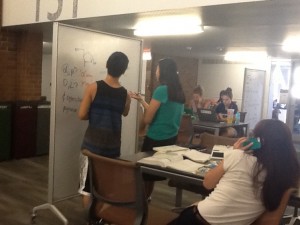David Murray (librarian for History, Latin America, Spanish & Portuguese) in the RIS department partnered with faculty member Ron Webb to teach The Legacy of Mesoamerica this spring. In this conversation with Assessment Librarian Nancy Turner, he describes his work as an “embedded librarian”, the assessment he conducted as part of that work, and considers the value of embedded librarians in contributing to student research success.
NT: Tell me about your project.
DM: I worked with Professor Webb for 9 to 12 months to put together a course and syllabus on The Legacy of Mesoamerica. The goal was to move beyond the imparting of ACRL’s standard for information literacy instruction, the so-called one-shot instruction session, and to instead embed information literacy into the curriculum. We went beyond the one-shot by having me, the librarian, convey or impart course content as well as those information literacy skills. We thought having the librarian deliver course content, in this case a series of lectures on Classic Maya art and architecture, would incline the students to take the information literacy component of the course more seriously.
There were three information literacy assignments within this course, and one “warm up” exercise that we can use as a “pre-test” of students’ skills. The primary assignment was an annotated bibliography, which was graded using a rubric provided to the students.
I had several questions.
- Are there indications of student learning, based on comparing the pre-test to the skills demonstrated in the annotated bibliography?
- Did the students feel that having a librarian in the classroom improved their understanding and skills with the research process?
- Did the improvements in student skills justify the time spent on the class and with the students?
For the first question I could compare the IL skills manifested in the “warm-up” assignment (pre-test) against those of the annotated bibliography. The two are not directly comparable, however, except in the sense that for both I asked students to describe the research process. In other words, the two assignments differ structurally. Yet I believe when properly compared can reflect changes in the students’ approach to finding, using, and evaluating information sources for academic work.
I used a survey to get at the second question. The survey was intended to measure perceptions and attitudes, not knowledge.
NT: Tell us about your results
DM: 7 out of 9 students responded to the survey. 2 were not in class that day.
The top three skills the students felt they learned were:
- “Choosing the most appropriate method and tool for accessing information”
- “Recognizing and employing “subject” searches in library databases and catalogs such as Diamond”
- “Learning how to critically evaluate sources of information for college-level research”
Most students expressed some level of appreciation for having a librarian closely involved with the course. One student valued having a “second opinion” available on papers. Another stated, “… by seeing the librarian so much in class it created a closer relationship between him and the students that made it more likely to maintain communication,” an indication, perhaps, that at least one student perceives value in establishing a long-term connection with a librarian.
I used a rubric to grade the annotated bibliography. While rubrics are practical and help students to understand the expectations, I don’t want to have students just “parrot” back to me what they know I want to hear. I haven’t yet systematically compared the pre-test to the annotated bibliography, but a preliminary comparison suggests students learned to become more sophisticated in their approach to information. For example, one of the students – an excellent student, I might add – progressed significantly in her understanding of the use of primary and secondary sources in her research. Several students also demonstrated, pre- vs. post-test, a better understanding of which of the many library databases available to them would likely uncover the most relevant sources for their topics. Finally, I noticed that several students were able to demonstrate an improvement in their basic understanding of search syntax (or the way a search is expressed in the database).
NT: Is there anything you were surprised by?
DM: I was surprised that learning to use subject headings for searching was important to the students. Librarians debate the utility of teaching students what we, as insiders, refer to as “controlled vocabulary.” Reference and cataloging librarians know the importance of subject headings, but some in our field claim that students and other library patrons do not appreciate subject headings, and cannot learn to use them effectively. Given this internal debate, I was pleasantly surprised to discover that my students expressed an appreciation for learning how to recognize and employ subject headings and other controlled vocabulary. Strangely, only three students said they learned to understand “what constitutes plagiarism and acknowledging the use of sources through proper citation.” I say strange because we emphasized the importance of mastering American Anthropological Association (AAA)-style citation in class, in the course guide, and on the assignment prompts.
NT: What are your next steps?
Students appreciated both the help with research and the writing. This means that partnerships with the Writing Center might be useful. Either the time spent on citing sources was not effective (students’ annotated bibliographies suggest it was effective), or perhaps more likely students felt they didn’t need it.
Overall, being truly embedded into the class is a lot of work for the benefit of a relatively small number of students. Because of this commitment, there are always questions about how sustainable “embedded librarian” initiatives such as this one really are in the world of academic librarianship. Ethically, it is important to consider the extent to which devoting so much time and effort to the needs of a small number of students might impact the hundreds of other history and Spanish students who fall into my portfolio. Ultimately, I feel that in terms of student learning all the hard work was and will continue to be well worth the effort. I would not have committed to such an endeavor if I felt my other students were getting short shrift, and I now have three years of experience teaching this course and can say with some confidence that, at least for me, such an initiative can be sustained.
Librarians are concerned, rightly, about democratizing access to our services; we always want to make sure we’re reaching as many students as possible! It’s all about maintaining a balance, and yet we can probably do the most good by focusing our time and attention on those faculty and students who are most receptive to what we have to offer. One thing is for sure, the teaching role of the academic librarian has increased exponentially over the last 10-to-20 years, a trend that at this point is hard to ignore. TULibraries is recognized for its instruction efforts. While my “embedded librarian” course is only one small part of those efforts, I hope to continue refining and improving the embedded course.
For more information on David’s work, contact him at dcm@temple.edu or visit his guide for this class at: http://guides.temple.edu/las2098


